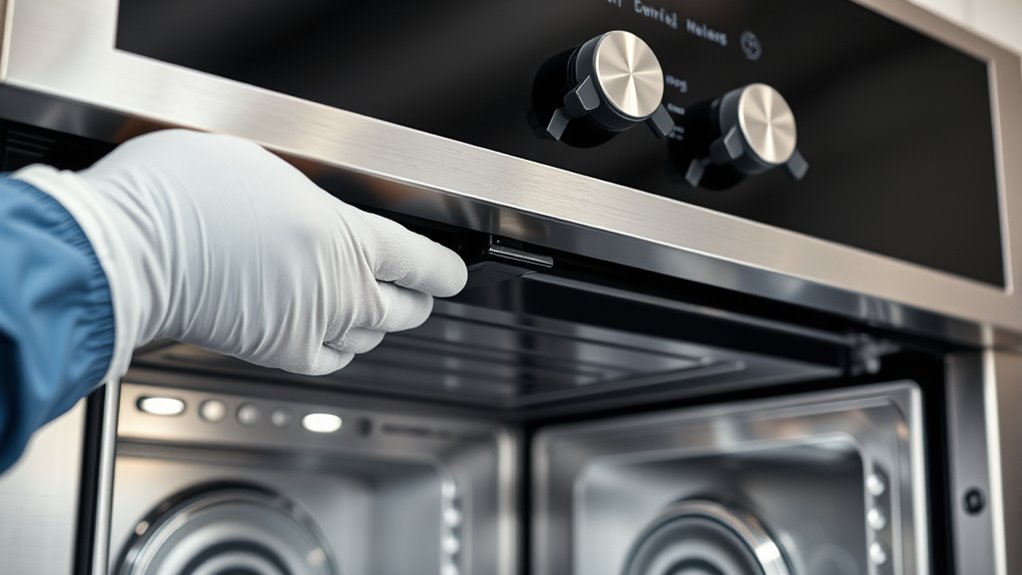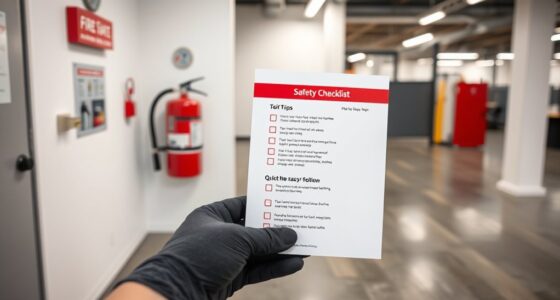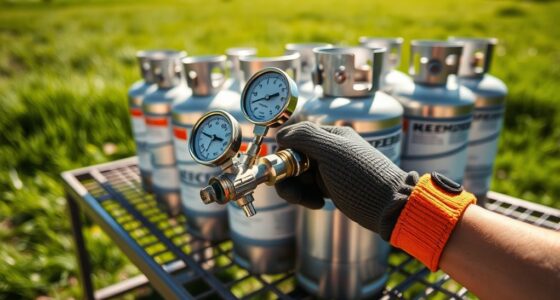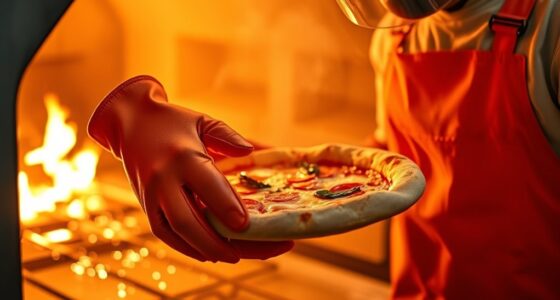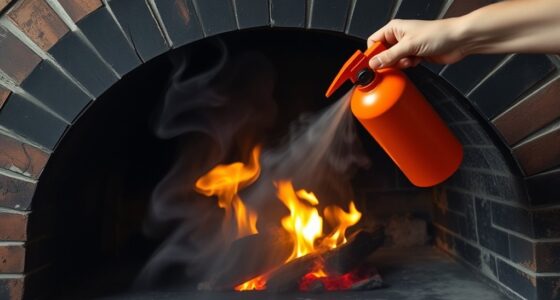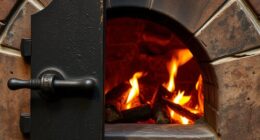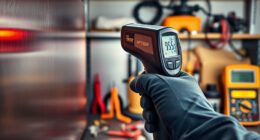Before firing up your oven, it’s essential to guarantee it’s stable and secure. Check that it’s level and firmly anchored, especially if built-in or mounted. Look for loose tiles, uneven flooring, or loose bolts and tighten them as needed. Regularly inspect the surrounding area for stability hazards. Performing these checks helps prevent accidents, avoids damage, and keeps your home safe. Keep going to learn more about maintaining a safe and reliable oven.
Key Takeaways
- Verify the oven is level and firmly anchored to prevent tilting or shifting during use.
- Inspect the surrounding area for loose tiles, uneven flooring, or other stability hazards.
- Tighten any loose bolts, brackets, or mounting hardware to secure the oven in place.
- Check that ventilation systems are unobstructed and functioning properly to ensure safe gas and fume dispersal.
- Perform a routine safety check, including gas leak detection and structural stability, before firing up the oven.
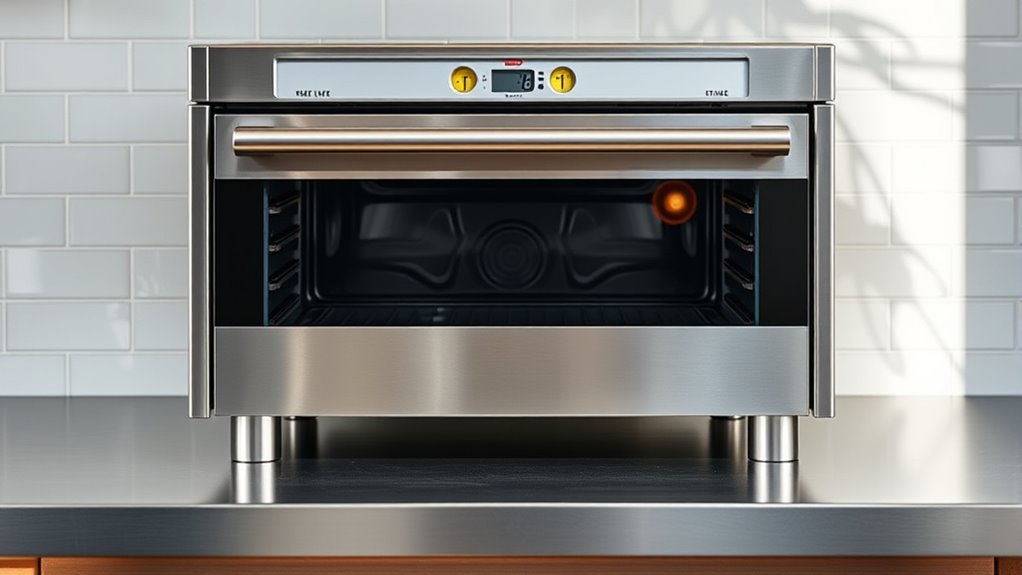
Stability checks are vital tools for guaranteeing that systems, structures, or processes remain safe and reliable over time. When it comes to preparing your oven for use, these checks become especially important to prevent accidents and assure safe operation. One key aspect is verifying that your oven is stable and secure, which involves inspecting for potential hazards such as gas leaks and ventilation safety concerns. If your oven runs on gas, a small leak can pose significant risks, including fire or poisoning. Before firing up the oven, you should perform a thorough check for any signs of leaks, such as a sulfur-like smell or hissing sound. If you notice any indication of a gas leak, turn off the appliance immediately and ventilate the area. Never attempt to fix a gas leak yourself unless you’re qualified—call a professional to handle it safely. Additionally, attention to detail during these checks can help identify small issues before they develop into major safety concerns. Ventilation safety is another vital aspect of stability checks. Proper ventilation ensures that any gases or fumes produced during operation are safely expelled, reducing the risk of accumulation that could lead to health hazards or explosions. Examine your oven’s ventilation system to guarantee nothing is blocked or obstructed. Clear out any debris or dust that might impede airflow, and confirm that ventilation ducts are properly connected and functional. Adequate airflow not only maintains safety but also helps your oven operate efficiently and evenly. Poor ventilation can cause overheating or uneven cooking, so don’t overlook this step. When checking your oven’s stability, also look at its physical position. Make sure it’s level and firmly anchored if necessary, especially if it’s built-in or mounted. An unsteady oven can tilt or shift during use, increasing the risk of accidents or damage. Check the stability of the surrounding area as well—loose tiles or uneven flooring can contribute to instability. Tighten any loose bolts or brackets, and if you notice instability, address it before proceeding. This proactive approach helps prevent mishaps while the oven is in use. Finally, always prioritize safety by performing these stability checks regularly, especially before cooking or baking. Be vigilant about signs of gas leaks or ventilation issues, and don’t hesitate to call professionals if you’re unsure. Remember, a stable, well-maintained oven isn’t just about quality results; it’s about safeguarding your home and loved ones. Taking a few minutes to ensure everything is secure can save you from potential disasters and prolong the lifespan of your appliance. Your safety depends on it, so stay vigilant and keep your oven in top condition before firing it up.
Frequently Asked Questions
How Often Should I Perform Stability Checks on My Oven?
You should perform stability checks on your oven at least once a year or whenever you notice irregular heating or calibration issues. Regular oven calibration helps maintain accurate temperature control, ensuring safety and efficiency. Follow safety guidelines by inspecting the oven’s mounting and support structures to prevent accidents. Consistent checks help catch problems early, keeping your oven safe and functioning properly, especially if you use it frequently or in a professional setting.
What Tools Are Recommended for Checking Oven Stability?
Think of checking your oven like keeping your eye on the ball. Use a bubble level or digital level specifically for oven leveling to guarantee stability. Safety tools such as a torque wrench can help tighten mounting brackets securely. A carpenter’s square also confirms proper alignment. These tools help prevent accidents and ensure your oven stays put, giving you peace of mind before firing it up.
Can Uneven Flooring Affect Oven Stability?
Uneven flooring can definitely affect oven stability. When the surface isn’t level, it causes uneven surface leveling, which can make the oven wobble or tip. To prevent accidents, you should assess the flooring’s evenness and use shims or adjustable feet if necessary. This guarantees your oven remains secure and stable during operation, reducing risks and improving safety in your cooking space.
What Signs Indicate My Oven May Be Unstable?
You’ll notice your oven may be unstable if it wobbles when you open the door, makes unusual noises, or feels uneven on the surface. Check the oven calibration to guarantee settings are accurate, and verify that safety lock features are engaged properly. If instability persists despite these, it’s best to tighten any loose parts or call a technician, as an unstable oven can be a safety hazard.
Are There Specific Safety Precautions During Stability Checks?
During stability checks, you should wear safety gear like gloves and eye protection to prevent injuries. Make sure to follow emergency procedures, such as having a fire extinguisher nearby and knowing how to shut off power quickly. Keep the area clear of unnecessary personnel, and double-check all connections before proceeding. These precautions help guarantee your safety and prevent accidents during the stability assessment process.
Conclusion
Before you fire up your oven, take a moment to double-check its stability. A secure, steady oven prevents accidents, ensuring safety and peace of mind. It might seem like a small step, but it’s vital—like the difference between a perfect bake and a messy disaster. So, don’t rush. Balance and security aren’t just details; they’re the foundation for successful cooking. Trust the process, stay vigilant, and let your oven do its job safely.
